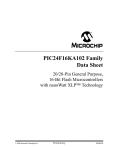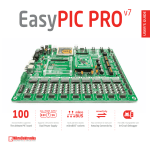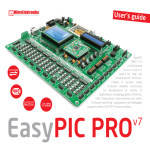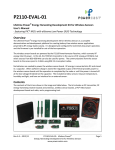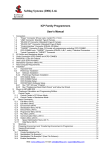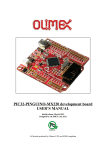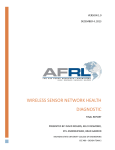Download mikroElektronika mikroProg Datasheet
Transcript
mikroProg ™ mikroProg™ is a fast USB programmer with mikroICD™ hardware In-Circuit Debugger support. Smart engineering allows mikroProg to support PIC10®, PIC12®, PIC16®, PIC18®, dsPIC30/33®, PIC24® and PIC32® devices in a single programmer! for PIC®, dsPIC® and PIC32® TO OUR VALUED CUSTOMERS I want to express my thanks to you for being interested in our products and for having confidence in MikroElektronika. The primary aim of our company is to design and produce high quality electronic products and to constantly improve the performance thereof in order to better suit your needs. Nebojsa Matic General Manager The PIC®, dsPIC®, PIC24®, PIC32® and Windows® logos and product names are trademarks of Microchip Technology® and Microsoft® in the U.S.A. and other countries. Page 2 Table of Contents Introduction to mikroProg™ 4 Key features 5 1. Driver installation 6 step 1 – Start installation 7 step 2 – Accept EULA 7 step 3 – Installing the drivers 8 step 4 – Finish installation 8 2. Connecting to a PC 9 3. mikroProg Suite™ for PIC® software 10 4. Powering device via mikroProg™ 11 5. Connecting with a target device 12 6. IDC10 Pinout 13 7. Connection examples 14 Using 1x5 male headers 14 Using 2x5 male headers 15 8. Multiplexer 16 Multiplexer in idle mode 18 Multiplexer in programming/debugging mode 19 10. Examples of connection schematics Page 3 20 Introduction to mikroProg™ mikroProg™ for PIC®, dsPIC® and PIC32® represents fast and reliable programmer with ICD support. Specially designed firmware allows programming of all Microchip® microcontrollers: PIC®, dsPIC®, PIC24® and PIC32®. And there’s no need for firmware change each time you select a new microcontroller architecture because mikroProg™ firmware takes care of all supported architectures. Supporting new microcontrollers is easy. Just by downloading the latest version of mikroProg Suite™ for PIC® your programmer is ready to program new devices. Page 4 Key features - In-Circuit Debugging (ICD). - One firmware for PIC®, dsPIC®, PIC24® and PIC32® microcontroller families - New microcontrollers support via latest version of mikroProg™ Suite for PIC® software - Can provide power supply for target device 01 02 03 04 05 01 Flat cable 06 02 USB MINIB connector 03 DATA transfer indication LED 04 ACTIVE indication LED 05 LINK indication LED 06 POWER indication LED Page 5 1. Driver installation mikroProg™ requires drivers in order to work. Drivers are located on the link bellow: http://www.mikroe.com/downloads/get/1202/mikroprog_for_pic_drivers_v200.zip When you locate the drivers, please extract files from the ZIP archive. Folder with extracted files contains folders with drivers for different operating systems. Depending on which operating system you use, choose adequate folder and open it. In the opened folder you should be able to locate the driver setup file. Double click on setup file to begin installation of the programmer drivers. Page 6 step 1 – Start installation step 2 – Accept EULA 01 01 02 01 In welcome screen click on Next> button 01 In order to proceed select: I accept the this EULA (End User License Agreement) 02 Click Next> button Page 7 step 3 – Installing the drivers step 4 – Finish installation 01 01 01 Click on Finish button to end installation process 01 Drivers are installed automatically Page 8 2. Connecting to a PC After driver installation is complete, you can now connect the programmer with your PC using USB cable provided with the package. Green POWER LED should turn ON, indicating the presence of power supply. Amber-colored LINK LED will turn ON when link between mikroProg™ and PC is established. Link can be established only when correct drivers are installed on your PC. Page 9 3. mikroProg Suite™ for PIC® software mikroProg Suite™ for PIC® software is intended for programming PIC®, dsPIC®, PIC24® and PIC32® microcontrollers from Microchip®. The graphic interface of this program is clear and easy-to-use, which makes the use of this program faster. The program’s main window includes basic options for programming microcontrollers. In addition, there are advanced programming options that enable experienced users to set configuration bits on their own. The program includes views providing basic information about the selected MCU, voltage monitoring, etc. Page 10 4. Powering target device via mikroProg™ One of the key benefits of mikroProg™ is that is can power your target device. You can set power supply voltage in range from 2.7V to 5V with output current up to 250mA. This option is activated from mikroProg Suite™ for PIC® (v2.29) software. Click the MCU Info button to display Voltage Options section. First you must select MCU family and choose your target MCU from a dropdown list. mikroProg™ will automatically set the default value of power supply for your MCU. You can also manually set voltage supply value by moving slider under mikroProg Suite™ for PIC® window, Figure 4-1. 02 01 To enable power supply, first set desired voltage and then click on check box “Power board from programmer”. 03 Figure 4-1: Voltage options 01 Setting supply voltage value from 2.7 to 5V (max 250mA) 02 Check box for enabling supply voltage from programmer 03 Box with selected supply voltage Page 11 5. Connecting with a target device For connection with a target device mikroProg™ uses female IDC10 connector, Figure 5-1. In order to make proper connection with the target board it is necessary to pay attention to IDC10 connector pinout. Every pin has a different purpose and for easy orientation IDC10 connector is marked with a little knob and incision, Figure 5- 2. Figure 5-2: Knob and incision for easy orientation First pin Front side of IDC10 connector is marked with a knob and incision. Front side holds PGC, PGD and MCLR pins which are used for microcontroller programming. Figure 5-1: IDC10 connector Page 12 6. IDC10 Pinout 01 MCU-VCC - MCU power supply 03 MCU-PGC - Serial programming clock 05 MCU-PGD - Serial programming data 09 10 07 08 05 06 03 04 01 02 07 MCU-MCLR - Master clear/Programming voltage 09 GND - Ground 02 VCC 04 PGC 06 PGD 08 MCLR These pins are multiplexed (see section 8.0 for more information) 10 GND Figure 6-1: IDC10 pinout Page 13 Figure 7-1: Use only front row for programming 7. Connection examples For connecting mikroProg™ with your target device a best solution is to provide 1x5 or 2x5 male headers which are connected with programing pins on microcontroller. You can see several examples of connection schematics in the Section 10 of this manual. Using 1x5 male headers When connecting mikroProg™ with your device via 1x5 header make sure to use front side of IDC10 connector (side with a knob and incision), Figure 7-2. 1x5 programming headers are found in some of Mikroelektronika products, like mikromedia boards, Figure 7-2. Figure 7-2: Connecting mikroProg™ to mikromedia board via 1x5 male header Page 14 Figure 7-3: Use entire IDC10 connector for multiplexing feature Using 2x5 male headers By using 2x5 male connector in your device you can exploit the multiplexing feature of mikroProg™ for PIC®, dsPIC® and PIC32®. We’ll explain how multiplexer operates and what are it’s key benefits in Section 8 of this manual. Figure 7-4: Connecting mikroProg™ with Ready for PIC® via 2x5 male header Page 15 8. Multiplexer Programming pins or I/Os? Figure 8-1: mikroProg™ 2x5 male header next to reset button RB7 RB6 RB5 RB4 RB3 RB2 RB1 RB0 VCC GND RD7 RD6 RD5 RD4 RC7 RC6 RC5 RC4 RD3 RD2 40 39 38 37 36 35 34 33 32 31 30 29 28 27 26 25 24 23 22 21 MCU-PGC MCU-PGD MCU-MCLR MCU-VCC MCLR MCLR RA0 RA1 RA2 RA3 RA4 RA5 RE0 RE1 RE2 VCC GND RA7 RA6 RC0 RC1 RC2 RC3 RD0 RD1 VCC PGC-RB6 1 2 3 4 5 6 7 8 9 10 11 12 13 14 15 16 17 18 19 20 MCU-VCC PGD-RB7 MCU-VCC PIC18F45K22 Multiplexer is specially designed circuit which serves as a switch. Purpose of multiplexer is that there’s no need for disconnecting mikroProg™ programmer from a device when programming is finished. Multiplexing is always available, but can only be used with 2x5 male header on target board as shown on Figure 8-1. Multiplexer allows the usage of programming pins (PGC and PGD) as I/O lines when not in programming/debugging mode. Master clear reset (MCLR) pin is also multiplexed and can be used for resetting target MCU when not in programming/ debugging mode. 1K R R 10K R 100nF RESET Figure 8-2: Having 2x5 programmer header, programming lines are separated from rest of the circuit. While pins on MCU are separated from rest of the circuit, they can not be used as I/O or reset pins as shown on Figure 8-2. There are two ways to connect programming pins: 1. with mikroProg™ 2x5 female connector 2. by placing jumpers over 2x5 male header. Page 16 Multiplexer decides pin function MCLR RA0 RA1 RA2 RA3 RA4 RA5 RE0 RE1 RE2 VCC GND RA7 RA6 RC0 RC1 RC2 RC3 RD0 RD1 RB7 RB6 RB5 RB4 RB3 RB2 RB1 RB0 VCC GND RD7 RD6 RD5 RD4 RC7 RC6 RC5 RC4 RD3 RD2 40 39 38 37 36 35 34 33 32 31 30 29 28 27 26 25 24 23 22 21 MCU-PGC MCU-PGD MCU-MCLR VCC MCU-VCC PGC-RB6 PGD-RB7 MCLR 1 2 3 4 5 6 7 8 9 10 11 12 13 14 15 16 17 18 19 20 MCU-VCC 1K R R 10K R 100nF RESET Figure 8-3: Multiplexer allows the usage of programming pins as I/O and MCLR pin as reset when not in programming/ debugging mode MCU-VCC MCLR RA0 RA1 RA2 RA3 RA4 RA5 RE0 RE1 RE2 VCC GND RA7 RA6 RC0 RC1 RC2 RC3 RD0 RD1 PIC18F45K22 1 2 3 4 5 6 7 8 9 10 11 12 13 14 15 16 17 18 19 20 MCU-VCC PIC18F45K22 MCU-VCC Programming pins just as I/Os RB7 RB6 RB5 RB4 RB3 RB2 RB1 RB0 VCC GND RD7 RD6 RD5 RD4 RC7 RC6 RC5 RC4 RD3 RD2 40 39 38 37 36 35 34 33 32 31 30 29 28 27 26 25 24 23 22 21 MCU-PGC MCU-PGD MCU-MCLR VCC PGC-RB6 PGD-RB7 MCLR MCU-VCC 1K R R 10K R 100nF RESET Figure 8-4: When mikroProg™ is removed place jumpers over 2x5 male header in order to use programming pins as I/O and MCLR pin as reset Programming/debugging is enabled when mikroProg™ is connected to the device. As shown on Figure 8-3, when programming/debugging is finished, multiplexer reconnects programming/debugging pins so they can be used as I/Os. There’s no need to remove mikroProg™ connector. When mikroProg™ is removed, place jumpers over 2x5 male header in order to use programming/debugging pins as I/O, and MCLR pin as reset (Figure 8-4). In programming/debugging mode MCLR pin is used by mikroProg™, otherwise it is used by MCU. Page 17 Multiplexer in idle mode mikroProg for PIC Multiplexer MCU-PGD PGC MCU-PGC PROG MCLR MCU-MCLR MCU-VCC PGD VCC MCU-VCC MCU-PGC MCU-PGD MCU-MCLR VCC DD+ GND USB DATA VCC BRD-PGC BRD-PGD BRD-MCLR IDC10 connector Figure 8-5: Multiplexer in the idle mode When programming/debugging is not in progress, the multiplexer releases the programming pins and MCLR, thus enabling them to be used as I/O pins or reset. This also enables the programmer to be connected to the target device without affecting its operation. Page 18 Multiplexer in programming/debugging mode mikroProg for PIC Multiplexer MCU-PGD PGC MCU-PGC VCC DD+ GND PROG MCLR MCU-MCLR MCU-VCC PGD VCC MCU-VCC MCU-PGC MCU-PGD MCU-MCLR USB DATA VCC BRD-PGC BRD-PGD BRD-MCLR IDC10 connector Figure 8-6: Multiplexer in the programming/ debugging mode During programming/debugging, the multiplexer disconnects the microcontroller pins used for programming/debugging from the target device. This enables the programming/debugging process to be safely performed without affecting the operation of the device itself. It also prevents external signals from affecting the programming/debugging process. When the programming/debugging process has been completed, the multiplexer releases the microcontroller pins used for programming, so that they can be used as I/O pins or reset respectively. Page 19 10. Examples of connection schematics Following examples demonstrate connections with some of the most popular supported MCUs. For all other MCUs consult manufacturer’s datasheet. All PIC®, dsPIC® and PIC32® MCUs use PGC, PGD and MCLR/ Vpp pins for programming. Some MCUs have several groups of programming pins. For example dsPIC33FJ128GP710A has three pairs of programmable pins PGED1-PGEC1, PGED2PGEC2 or PGED3-PGEC3 (MCLR/Vpp pin is same for all pin groups). Whichever group of programming pins you decide to use, make sure to connect each pin properly. PGC - Serial programming clock PGD - Serial programming data MCLR/Vpp - Master clear/Programming voltage Note: In order for microcontroller to work properly, decoupling capacitors must be connected as close as possible to microcontroller’s VCC pins. Page 20 PIC DIP40 Figure 10-1: Connecting 2x5 male header with PIC18F2550 in 28-pin DIP package Figure 10-2: Connecting 2x5 male header with PIC16F887 in 40-pin DIP package MCU-VCC MCLR RA0 RA1 RA2 RA3 RA4 RA5 GND OSC1 RA6 RC0 RC1 RC2 Vusb PIC18F2550 1 2 3 4 5 6 7 8 9 10 11 12 13 14 RB7 RB6 RB5 RB4 RB3 RB2 RB1 RB0 VCC GND RC7 RC6 RC5 RC4 28 27 26 25 24 23 22 21 20 19 18 17 16 15 MCU-VCC VCC MCU-RB6/PGC MCU-RB7/PGD MCU-MCLR PGC-RB6 PGD-RB7 MCLR 1 2 3 4 5 6 7 8 9 10 11 12 13 14 15 16 17 18 19 20 USER INTERFACE MCU-VCC C 100nF Page 21 MCLR RA0 RA1 RA2 RA3 RA4 RA5 RE0 RE1 RE2 VCC GND RA7 RA6 RC0 RC1 RC2 RC3 RD0 RD1 PIC16F887 MCU-VCC MCU-VCC RB7 RB6 RB5 RB4 RB3 RB2 RB1 RB0 VCC GND RD7 RD6 RD5 RD4 RC7 RC6 RC5 RC4 RD3 RD2 40 39 38 37 36 35 34 33 32 31 30 29 28 27 26 25 24 23 22 21 MCU-RB6/PGC MCU-RB7/PGD MCU-MCLR VCC PGC-RB6 PGD-RB7 MCLR MCU-VCC MCU-VCC C1 C2 100nF 100nF USER INTERFACE Connection examples - PIC PIC DIP28 Figure 10-3: Connecting 2x5 male header with PIC18F45K22 in 40-pin DIP package MCU-VCC 1 2 3 4 5 6 7 8 9 10 11 12 13 14 15 16 17 18 19 20 MCU-VCC MCLR RA0 RA1 RA2 RA3 RA4 RA5 RE0 RE1 RE2 VCC GND RA7 RA6 RC0 RC1 RC2 RC3 RD0 RD1 PIC18F45K22 Connection examples - PIC18FK PIC18FK DIP40 RB7 RB6 RB5 RB4 RB3 RB2 RB1 RB0 VCC GND RD7 RD6 RD5 RD4 RC7 RC6 RC5 RC4 RD3 RD2 40 39 38 37 36 35 34 33 32 31 30 29 28 27 26 25 24 23 22 21 MCU-RB6/PGC MCU-RB7/PGD MCU-MCLR Page 22 VCC PGC-RB6 PGD-RB7 MCLR MCU-VCC MCU-VCC C1 C2 100nF 100nF USER INTERFACE Figure 10-4: Connecting 2x5 male header with PIC18F8722 in 80-pin TQFP package MCU-VCC MCU-VCC VCC PGC-RB6 PGD-RB7 MCLR USER INTERFACE RH1 RH0 RE2 RE3 RE4 RE5 RE6 RE7 RD0 VCC GND RD1 RD2 RD3 RD4 RD5 RD6 RD7 RJ0 RJ1 80 79 78 77 76 75 74 73 72 71 70 69 68 67 66 65 64 63 62 61 MCU-RB6/PGC MCU-RB7/PGD MCU-MCLR PIC18F8722 RJ2 RJ3 RB0 RB1 RB2 RB3 RB4 RB5 PGC/RB6 GND OSC2/RA6 OSC1/RA7 VCC PGD/RB7 RC5 RC4 RC3 RC2 RJ7 RJ6 60 59 58 57 56 55 54 53 52 51 50 49 48 47 46 45 44 43 42 41 RH5 RH4 RF1 RF0 AVCC AGND RA3 RA2 RA1 RA0 GND VCC RA5 RA4 RC1 RC0 RC6 RC7 RJ4 RJ5 RH2 RH3 RE1 RE0 RG0 RG1 RG2 RG3 MCLR RG4 GND VCC RF7 RF6 RF5 RF4 RF3 RF2 RH7 RH6 21 22 23 24 25 26 27 28 29 30 31 32 33 34 35 36 37 38 39 40 1 2 3 4 5 6 7 8 9 10 11 12 13 14 15 16 17 18 19 20 Page 23 MCU-VCC MCU-VCC MCU-VCC MCU-VCC MCU-VCC C1 C2 C3 C4 C5 100nF 100nF 100nF 100nF 100nF Connection examples - PIC18F PIC18F TQFP80 Figure 10-5: Connecting 2x5 male header with PIC18F87K22 in 80-pin TQFP package MCU-VCC MCU-VCC VCC PGC-RB6 PGD-RB7 MCLR USER INTERFACE RH1 RH0 RE2 RE3 RE4 RE5 RE6 RE7 RD0 VCC GND RD1 RD2 RD3 RD4 RD5 RD6 RD7 RJ0 RJ1 80 79 78 77 76 75 74 73 72 71 70 69 68 67 66 65 64 63 62 61 MCU-RB6/PGC MCU-RB7/PGD MCU-MCLR 10uF RH2 RH3 RE1 RE0 RG0 RG1 RG2 RG3 MCLR RG4 GND Vcap RF7 RF6 RF5 D+ DRF2 RH7 RH6 PIC18F87K22 RJ2 RJ3 RB0 RB1 RB2 RB3 RB4 RB5 PGC/RB6 GND OSC2/RA6 OSC1/RA7 VCC PGD/RB7 RC5 RC4 RC3 RC2 RJ7 RJ6 RH5 RH4 RF1/VUSB ENVREG/RF0 AVCC AGND RA3 RA2 RA1 RA0 GND VCC RA5 RA4 RC1 RC0 RC6 RC7 RJ4 RJ5 E1 1 2 3 4 5 6 7 8 9 10 11 12 13 14 15 16 17 18 19 20 60 59 58 57 56 55 54 53 52 51 50 49 48 47 46 45 44 43 42 41 21 22 23 24 25 26 27 28 29 30 31 32 33 34 35 36 37 38 39 40 Connection examples - PIC18FK PIC18FK TQFP80 Page 24 MCU-VCC MCU-VCC MCU-VCC MCU-VCC C1 C2 C3 C4 100nF 100nF 100nF 100nF Figure 10-6: Connecting 2x5 male header with PIC18F87J50 in 80-pin TQFP package MCU-VCC MCU-VCC VCC PGC-RB6 PGD-RB7 MCLR USER INTERFACE RH1 RH0 RE2 RE3 RE4 RE5 RE6 RE7 RD0 VCC GND RD1 RD2 RD3 RD4 RD5 RD6 RD7 RJ0 RJ1 80 79 78 77 76 75 74 73 72 71 70 69 68 67 66 65 64 63 62 61 MCU-RB6/PGC MCU-RB7/PGD MCU-MCLR PIC18F87J50 RJ2 RJ3 RB0 RB1 RB2 RB3 RB4 RB5 PGC/RB6 GND OSC2/RA6 OSC1/RA7 VCC PGD/RB7 RC5 RC4 RC3 RC2 RJ7 RJ6 RH5 RH4 Vusb ENVREG AVCC AGND RA3 RA2 RA1 RA0 GND VCC RA5 RA4 RC1 RC0 RC6 RC7 RJ4 RJ5 10uF RH2 RH3 RE1 RE0 RG0 RG1 RG2 RG3 MCLR RG4 GND Vcap RF7 RF6 RF5 D+ DRF2 RH7 RH6 60 59 58 57 56 55 54 53 52 51 50 49 48 47 46 45 44 43 42 41 21 22 23 24 25 26 27 28 29 30 31 32 33 34 35 36 37 38 39 40 E1 1 2 3 4 5 6 7 8 9 10 11 12 13 14 15 16 17 18 19 20 Page 25 MCU-VCC MCU-VCC MCU-VCC MCU-VCC C1 C2 C3 C4 100nF 100nF 100nF 100nF Connection examples - PIC18FJ PIC18FJ TQFP80 Figure 10-7: Connecting 2x5 male header with PIC18F87J60 in 80-pin TQFP package MCU-VCC MCU-VCC RH1 RH0 RE2 RE3 RE4 RE5 RE6 RE7 RD0 VCC GND RD1 RD2 VssPLL VccPLL RBIAS VssTX TPOUT+ TPOUTVccTX PIC18F87J60 VccRX TPIN+ TPINVssRX RG0 RG1 RB4 RB5 PGC/RB6 GND OSC2 OSC1 VCC PGD/RB7 RC5 RC4 RC3 RC2 RG2 RG3 Page 26 VCC MCU-RB6/PGC MCU-RB7/PGD MCU-MCLR 80 79 78 77 76 75 74 73 72 71 70 69 68 67 66 65 64 63 62 61 10uF RH2 RH3 RE1 RE0 RB0 RB1 RB2 RB3 MCLR RG4 GND Vcap RF7 RF6 RF5 RF4 RF3 RF2 RH7 RH6 RH5 RH4 RF1 ENVREG AVCC AGND RA3 RA2 RA1 RA0 GND VCC RA5 RA4 RC1 RC0 RC6 RC7 RJ4 RJ5 E1 1 2 3 4 5 6 7 8 9 10 11 12 13 14 15 16 17 18 19 20 21 22 23 24 25 26 27 28 29 30 31 32 33 34 35 36 37 38 39 40 Connection examples - PIC18FJ PIC18FJ TQFP80 60 59 58 57 56 55 54 53 52 51 50 49 48 47 46 45 44 43 42 41 PGC-RB6 PGD-RB7 MCLR USER INTERFACE MCU-VCC MCU-VCC MCU-VCC MCU-VCC C1 C2 C3 C4 100nF 100nF 100nF 100nF Figure 10-8: Connecting 2x5 male header with dsPIC30F4013 in 40-pin DIP package MCU-VCC MCU-VCC VCC 1 2 3 4 5 6 7 8 9 10 11 12 13 14 15 16 17 18 19 20 MCLR RB0 RB1 RB2 RB3 RB4 RB5 RB6 RB7 RB8 VCC GND OSC1 OSC2 RC13 RC14 RA11 RD9 RD3 GND dsPIC30F4013 MCU-RB6/PGC MCU-RB7/PGD MCU-MCLR AVCC AGND RB9 RB10 RB11 RB12 RD0 RD1 VCC GND RF0 RF1 RF4 RF5 RF2 RF3 RF6 RD8 RD2 VCC 40 39 38 37 36 35 34 33 32 31 30 29 28 27 26 25 24 23 22 21 PGC-RB6 PGD-RB7 MCLR USER INTERFACE MCU-VCC MCU-VCC MCU-VCC MCU-VCC C1 C2 C3 C4 100nF 100nF 100nF 100nF Page 27 Connection examples - dsPIC30 dsPIC30 DIP40 Figure 10-9: Connecting 2x5 male header with dsPIC30F6014A in 80-pin TQFP package MCU-VCC MCU-VCC 80 79 78 77 76 75 74 73 72 71 70 69 68 67 66 65 64 63 62 61 RG13 RG12 RG14 RA7 RA6 RG0 RG1 RF1 RF0 VCC GND RD7 RD6 RD5 RD4 RD13 RD12 RD3 RD2 RD1 RG15 RC1 RC2 RC3 RC4 RG6 RG7 RG8 MCLR RG9 GND VCC RA12 RA13 RB5 RB4 RB3 RB2 RB1 RB0 dsPIC30F6014A RC14 RC13 RD0 RD11 RD10 RD9 RD8 RA15 RA14 GND OSC2 OSC1 VCC RG2 RG3 RF6 RF7 RF8 RF2 RF3 60 59 58 57 56 55 54 53 52 51 50 49 48 47 46 45 44 43 42 41 RB6 RB7 RA9 RA10 AVCC AGND RB8 RB9 RB10 RB11 GND VCC RB12 RB13 RB14 RB15 RD14 RD15 RF4 RF5 1 2 3 4 5 6 7 8 9 10 11 12 13 14 15 16 17 18 19 20 VCC MCU-RB6/PGC MCU-RB7/PGD MCU-MCLR 21 22 23 24 25 26 27 28 29 30 31 32 33 34 35 36 37 38 39 40 Connection examples - dsPIC30 dsPIC30 TQFP80 Page 28 PGC-RB6 PGD-RB7 MCLR USER INTERFACE MCU-VCC MCU-VCC MCU-VCC MCU-VCC MCU-VCC C1 C2 C3 C4 C5 100nF 100nF 100nF 100nF 100nF MCU-VCC E1 10uF RE4 RE3 RE2 RG13 RG12 RG14 RE1 RE0 RA7 RA6 RG0 RG1 RF1 RF0 VCC VCAP RD7 RD6 RD5 RD4 RD13 RD12 RD3 RD2 RD1 100 99 98 97 96 95 94 93 92 91 90 89 88 87 86 85 84 83 82 81 80 79 78 77 76 MCU-RB6/PGC MCU-RB7/PGD MCU-MCLR dsPIC33FJ256GP710A RB6/PGEC1 RB7/PGED1 RA9/VrefRA10/Vref+ AVCC AGND RB8 RB9 RB10 RB11 GND VCC RA1 RF13 RF12 RB12 RB13 RB14 RB15 GND VCC RD14 RD15 RF4 RF5 RG15 VCC RE5 RE6 RE7 RC1 RC2 RC3 RC4 RG6 RG7 RG8 MCLR RG9 GND VCC RA0 RA12 RA13 RB5 RB4 RB3 RB2 RB1 RB0 GND RC14 RC13 RD0 RD11 RD10 RD9 RD8 RA15 RA14 GND RC15 RC12 VCC RA5 RA4 RA3 RA2 RG2 RG3 RF6 RF7 RF8 RF2 RF3 75 74 73 72 71 70 69 68 67 66 65 64 63 62 61 60 59 58 57 56 55 54 53 52 51 PGC-RB6 PGD-RB7 MCLR USER INTERFACE MCU-VCC MCU-VCC MCU-VCC MCU-VCC MCU-VCC MCU-VCC C1 C2 C3 C4 C5 C6 100nF 100nF 100nF 100nF 100nF 100nF dsPIC33 TQFP100 26 27 28 29 30 31 32 33 34 35 36 37 38 39 40 41 42 43 44 45 46 47 48 49 50 1 2 3 4 5 6 7 8 9 10 11 12 13 14 15 16 17 18 19 20 21 22 23 24 25 VCC Figure 10-10: Connecting 2x5 male header with dsPIC303FJ256GP710A in 100-pin TQFP package Page 29 Connection examples - dsPIC33 MCU-VCC Figure 10-11: Connecting 2x5 male header with PIC24F16KA102 in 28-pin DIP package MCU-VCC 1 2 3 4 5 6 7 8 9 10 11 12 13 14 MCLR RA0 RA1 RB0 RB1 RB2 RB3 GND OSCI OSCO RB4 RA4 VCC RB5 PIC24F16KA102 Connection examples - PIC24 PIC24FK TQFP80 VCC GND RB15 RB14 RB13 RB12 RB11 RB10 RA6 RA7 RB9 RB8 RB7 RB6 28 27 26 25 24 23 22 21 20 19 18 17 16 15 MCU-VCC MCU-RB1/PGC MCU-RB0/PGD MCU-MCLR VCC PGC-RB1 PGD-RB0 MCLR MCU-VCC MCU-VCC RD3 Page 30 C1 C2 100nF 100nF USER INTERFACE MCU-VCC 10uF PIC24FJ256GB110 GND RC14 RC13 RD0 RD11 RD10 RD9 RD8 RA15 RA14 GND RC15 RC12 VCC RA5 RA4 RA3 RA2 D+ DVusb Vbus RF8 RF2 USBID/RF3 RB6/PGEC2 RB7/PGED2 RA9/VrefRA10/Vref+ AVCC AGND RB8 RB9 RB10 RB11 GND VCC RA1 RF13 RF12 RB12 RB13 RB14 RB15 GND VCC RD14 RD15 RF4 RF5 RG15 VCC RE5 RE6 RE7 RC1 RC2 RC3 RC4 RG6 RG7 RG8 MCLR RG9 GND VCC RA0 RE8 RE9 RB5 RB4 RB3 RB2 RB1 RB0 RE4 RE3 RE2 RG13 RG12 RG14 RE1 RE0 RA7 RA6 RG0 RG1 RF1 RF0 ENVREG VCAP RD7 RD6 RD5 RD4 RD13 RD12 RD3 RD2 RD1 100 99 98 97 96 95 94 93 92 91 90 89 88 87 86 85 84 83 82 81 80 79 78 77 76 MCU-RB6/PGC MCU-RB7/PGD MCU-MCLR 75 74 73 72 71 70 69 68 67 66 65 64 63 62 61 60 59 58 57 56 55 54 53 52 51 PGC-RB6 PGD-RB7 MCLR USER INTERFACE MCU-VCC MCU-VCC MCU-VCC MCU-VCC MCU-VCC MCU-VCC C1 C2 C3 C4 C5 C6 100nF 100nF 100nF 100nF 100nF 100nF PIC24FJ TQFP100 26 27 28 29 30 31 32 33 34 35 36 37 38 39 40 41 42 43 44 45 46 47 48 49 50 1 2 3 4 5 6 7 8 9 10 11 12 13 14 15 16 17 18 19 20 21 22 23 24 25 VCC Figure 10-12: Connecting 2x5 male header with PIC24FJ256BG110 in 100-pin TQFP package Page 31 Connection examples - PIC24 E1 MCU-VCC MCU-VCC E1 10uF MCU-RB6/PGC MCU-RB7/PGD MCU-MCLR 100 99 98 97 96 95 94 93 92 91 90 89 88 87 86 85 84 83 82 81 80 79 78 77 76 RE4 RE3 RE2 RG13 RG12 RG14 RE1 RE0 RA7 RA6 RG0 RG1 RF1 RF0 ENVREG VCAP RD7 RD6 RD5 RD4 RD13 RD12 RD3 RD2 RD1 RG15 VCC RE5 RE6 RE7 RC1 RC2 RC3 RC4 RG6 RG7 RG8 MCLR RG9 GND VCC RA0 RA12 RA13 RB5 RB4 RB3 RB2 RB1 RB0 PIC32MX460F512L RB6/PGEC2 RB7/PGED2 RA9 RA10 AVCC AGND RB8 RB9 RB10 RB11 GND VCC RA1 RF13 RF12 RB12 RB13 RB14 RB15 GND VCC RD14 RD15 RF4 RF5 1 2 3 4 5 6 7 8 9 10 11 12 13 14 15 16 17 18 19 20 21 22 23 24 25 VCC GND RC14 RC13 RD0 RD11 RD10 RD9 RD8 RA15 RA14 GND RC15 RC12 VCC RA5 RA4 RA3 RA2 RG2 RG3 Vusb Vbus RF8 RF2 RF3 75 74 73 72 71 70 69 68 67 66 65 64 63 62 61 60 59 58 57 56 55 54 53 52 51 PGC-RB6 PGD-RB7 MCLR USER INTERFACE MCU-VCC MCU-VCC MCU-VCC MCU-VCC MCU-VCC MCU-VCC C1 C2 C3 C4 C5 C6 100nF 100nF 100nF 100nF 100nF 100nF PIC32MX4 TQFP100 26 27 28 29 30 31 32 33 34 35 36 37 38 39 40 41 42 43 44 45 46 47 48 49 50 Connection examples - PIC32 MCU-VCC Figure 10-13: Connecting 2x5 male header with PIC32MX460F512L in 100-pin TQFP package Page 32 MCU-VCC E1 10uF RE4 RE3 RE2 RG13 RG12 RG14 RE1 RE0 RA7 RA6 RG0 RG1 RF1 RF0 VCC VCAP RD7 RD6 RD5 RD4 RD13 RD12 RD3 RD2 RD1 100 99 98 97 96 95 94 93 92 91 90 89 88 87 86 85 84 83 82 81 80 79 78 77 76 MCU-RB6/PGC MCU-RB7/PGD MCU-MCLR PIC32MX795F512L RB6/PGEC2 RB7/PGED2 RA9 RA10 AVCC AGND RB8 RB9 RB10 RB11 GND VCC RA1 RF13 RF12 RB12 RB13 RB14 RB15 GND VCC RD14 RD15 RF4 RF5 RG15 VCC RE5 RE6 RE7 RC1 RC2 RC3 RC4 RG6 RG7 RG8 MCLR RG9 GND VCC RA0 RE8 RE9 RB5 RB4 RB3 RB2 RB1 RB0 GND RC14 RC13 RD0 RD11 RD10 RD9 RD8 RA15 RA14 GND RC15 RC12 VCC RA5 RA4 RA3 RA2 D+ DVusb Vbus RF8 RF2 RF3 75 74 73 72 71 70 69 68 67 66 65 64 63 62 61 60 59 58 57 56 55 54 53 52 51 PGC-RB6 PGD-RB7 MCLR USER INTERFACE MCU-VCC MCU-VCC MCU-VCC MCU-VCC MCU-VCC MCU-VCC MCU-VCC C1 C2 C3 C4 C5 C6 C7 100nF 100nF 100nF 100nF 100nF 100nF 100nF PIC32MX7 TQFP100 26 27 28 29 30 31 32 33 34 35 36 37 38 39 40 41 42 43 44 45 46 47 48 49 50 1 2 3 4 5 6 7 8 9 10 11 12 13 14 15 16 17 18 19 20 21 22 23 24 25 VCC Figure 10-14: Connecting 2x5 male header with PIC32MX760F512L in 100-pin TQFP package Page 33 Connection examples - PIC32 MCU-VCC Notes: Page 34 DISCLAIMER All the products owned by MikroElektronika are protected by copyright law and international copyright treaty. Therefore, this manual is to be treated as any other copyright material. No part of this manual, including product and software described herein, may be reproduced, stored in a retrieval system, translated or transmitted in any form or by any means, without the prior written permission of MikroElektronika. The manual PDF edition can be printed for private or local use, but not for distribution. Any modification of this manual is prohibited. MikroElektronika provides this manual ‘as is’ without warranty of any kind, either expressed or implied, including, but not limited to, the implied warranties or conditions of merchantability or fitness for a particular purpose. MikroElektronika shall assume no responsibility or liability for any errors, omissions and inaccuracies that may appear in this manual. In no event shall MikroElektronika, its directors, officers, employees or distributors be liable for any indirect, specific, incidental or consequential damages (including damages for loss of business profits and business information, business interruption or any other pecuniary loss) arising out of the use of this manual or product, even if MikroElektronika has been advised of the possibility of such damages. MikroElektronika reserves the right to change information contained in this manual at any time without prior notice, if necessary. HIGH RISK ACTIVITIES The products of MikroElektronika are not fault – tolerant nor designed, manufactured or intended for use or resale as on – line control equipment in hazardous environments requiring fail – safe performance, such as in the operation of nuclear facilities, aircraft navigation or communication systems, air traffic control, direct life support machines or weapons systems in which the failure of Software could lead directly to death, personal injury or severe physical or environmental damage (‘High Risk Activities’). MikroElektronika and its suppliers specifically disclaim any expressed or implied warranty of fitness for High Risk Activities. TRADEMARKS The MikroElektronika name and logo, the MikroElektronika logo, mikroC™, mikroBasic™, mikroPascal™, mikroProg™, EasyPIC™, EasyPIC PRO™ and mikromedia™ are trademarks of MikroElektronika. All other trademarks mentioned herein are property of their respective companies. All other product and corporate names appearing in this manual may or may not be registered trademarks or copyrights of their respective companies, and are only used for identification or explanation and to the owners’ benefit, with no intent to infringe. Copyright © MikroElektronika, 2013, All Rights Reserved. Page 35 If you want to learn more about our products, please visit our website at www.mikroe.com If you are experiencing some problems with any of our products or just need additional information, please place your ticket at www.mikroe.com/support/ If you have any questions, comments or business proposals, do not hesitate to contact us at [email protected] mikroProg for PIC, dsPIC and PIC32 manual, ver. 2.21b 0 100000 025239




































